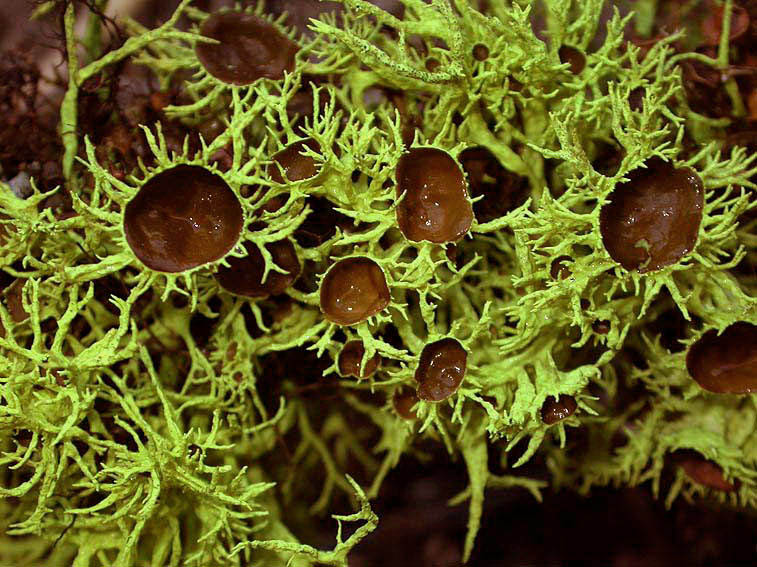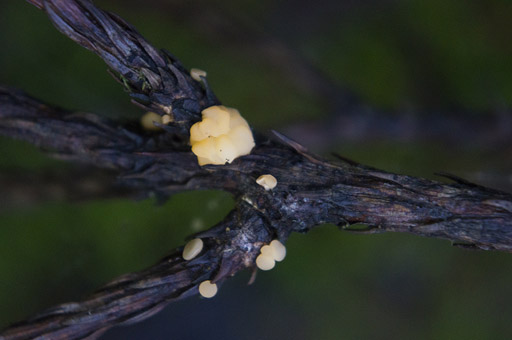
Small Operculate Cups - Pezizomycetes p.p. (Orbiliomycetes)
I am assuming that most cup fungi are saprophytic, but I don't know if that has been well studied. As with many of the smallest fungi, the seasons of fruiting are not reliably documented, so I am not going to try and fix a season to each species, but many can be found almost year round. Most are "ascos", but also included are the few small Basidiomycota on moss that more resemble cups than they do any of the Basidiomycota categories.
Operculate means that the asci (the microscopic structures inside which the spores grow after which the Ascomycota get their name) have a lid that opens up to release the spores. This is very difficult to see under a microscope, but it is a good indicator of which mushrooms are related to each other. This indicates that the morels, large cups and these small cups are related.
Exceptions - the following species are found on the ground or dung, but are actually inoperculate cup fungi and found on that page as well.
Thelebolus stercoreus - found on dung, <0.25mm, smooth, yellow-brown with a single protruding ascus with >1,000 spores.
Coprotus - also pale yellow on dung without marginal hairs and <1mm.
Discinella boudieri - brown disc <1cm, on bare soil, less colourful than most operculates found on the ground. Very much like a small Peziza.
I am separating the mushrooms in this group by habitat:
Take careful note of where you find it... burned ground and dung can be easy to overlook. This will especially be a problem if somebody gives you the specimen and you did not collect it yourself. You have may have to check all habitats.
Burned ground or burned wood - look for subtle signs of charcoal or other indications of a recent burn in the area.
Anthracobia macrocystis/
Geopyxis carbonaria (also shown) may sometimes be <1cm.
Pulvinula convexella/
Neottiella hetieri - <2mm, underside with tiny downy hairs, orangish cups to discs on moss covered old burns.
Pyronema domesticum - yellow- to pinkish-orange 1-2mm discs on a white mycelial mat fusing into a confluent mass. May grow indoors. Tiny hairs around perimeter.
P. omphalodes - no hairs.
Byssonectria fusispora - <5mm yellow-orange mass of discs that do not fuse, scanty mycelial mat. Compare B. cartilaginea.
Tricharina gilva - cup shaped when young (most others are flatter), yellow to orange, with pale, subtle hairs on margin. <5mm.
Trichophaea abundans - similar but brown or white inside, cup or disc, pale hairs on margin.
T. hemisphaerioides - obvious dark hairs, may be >1cm, more closely related to Humaria, which these both resemble.
Some species grow on normal ground.
Ascobolus carbonarius - <5mm, discs yellow-green to brown, turning black from maturing spores very spottily (see A. furfuraceus).
Dung - these species might also be found on manured soil or rotting plant debris, so the substrate is not always easy to recognize as belonging to this group.
Cheilymenia fimicola - ~5mm, orange, marginal eyelash hairs. Actually a Scutellinia.
C. stercorarea - < 3mm
C. theleboloides - ~5mm, hairs are thinner and paler, thus subtler.
Iodophanus carneus - <1mm pinkish, hairy knobs, sometimes on cloth. Asci turn blue in iodine like Peziza.
Ascobolus furfuraceus (stercorarius) etc. - maturing black spores create dark spots. ~2.5mm. There are a number of species.
Byssonectria cartilaginea - many 1mm orange discs on a white mycelial mat. Not fusing like Pyronema. See B. terrestris.
Peziza fimeti may be <1cm, smooth brown cups.
Other species on woody habitats where inoperculate cup fungi are normally found, so therefore also mentioned on that page:
Scutellinia scutellata - red discs with the longest eyelash hairs around the perimeter. <2cm.
S. erinaceus - yellow, shorter eyelashes, <5mm.
S. setosa - an orange-red S. erinaceus.
Other Scutellinia species may also be found on wood.
Adelphella (Pachyella) babingtonii - red- to yellow-brown translucent disc on wet wood. <1cm.
Miladina lecithina - brighter yellow-orange, <5mm.

P. cupressina - on cedar and juniper twigs. <5mm.
Pseudopithyella minuscula - scarlet, <3mm, southern species.
Moss or Ground - also check the Basidiomycota moss dwellers in the next group.
Byssonectria terrestris - many <5mm orange discs on a white mycelial mat. See other spp. in other habitats.
Pulvinula convexella/
Octospora/
Neottiella - sometimes more cup shaped, underside with tiny downy hairs. <1cm. All on moss.
Smardaea planchonis - dark purple, <8mm cup or disc on sandy soil. Similar Pezizas are larger on burnt ground and more cup-like.
Trichophaea gregaria - white, with brown completely hairy exterior, may grow on mossy ground (as could a small Humaria). (T. abundans shown).
Scutellinia umbrarum - <2cm, orange-red cups or discs with eyelash hairs on rim, occasionally on wood.
S. verrucipolaris - ~5mm, scarlet, occasionally on wood.
Cheilymenia (S.) crucipila - ~5mm, orange-red, hairs paler, harder to see.
Scutellinia scutellata - red to orange with the longest hairs, usually on wood. <2cm.
Some Peziza species can be <1cm. They are brown cups in various habitats.
Geopyxis and Tarzetta species may also be <1cm. Brown, deep cups with small mouths and pale, scalloped rims.
Geopora arenosa - buried in the sand, southern species <2cm.
Basidiomycota - there are just a few cup-shaped fungi that are not Ascomycota, but Basidiomycota. You would never know this unless you examine them under a microscope or recognize them from these pictures. Not only are they Basidiomycota, but they are closely related to the gilled mushrooms! Over the years they may have lost their gills kind of like you stopped using your appendix. They are rarely found, possibly because of their minuscule size and confusion with the small cup-like Ascomycota found on the rest of this page. They are found growing saprophytic on moss. Most might fruit year round. <1cm. They are also found on the Oddball page of gilled mushrooms.
Arrhenia 'retiruga' - white to pale grey. Agaricales (Hygrophoroid).
Rimbachia arachnoidea/
Muscinupta laevis (Cyphellostereum laeve) - stemmed moss dweller. May be in the Hymenochaetales.